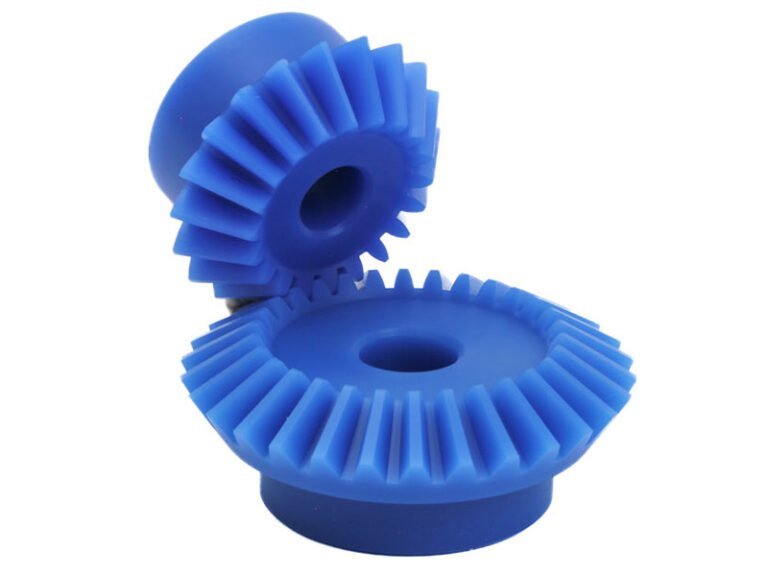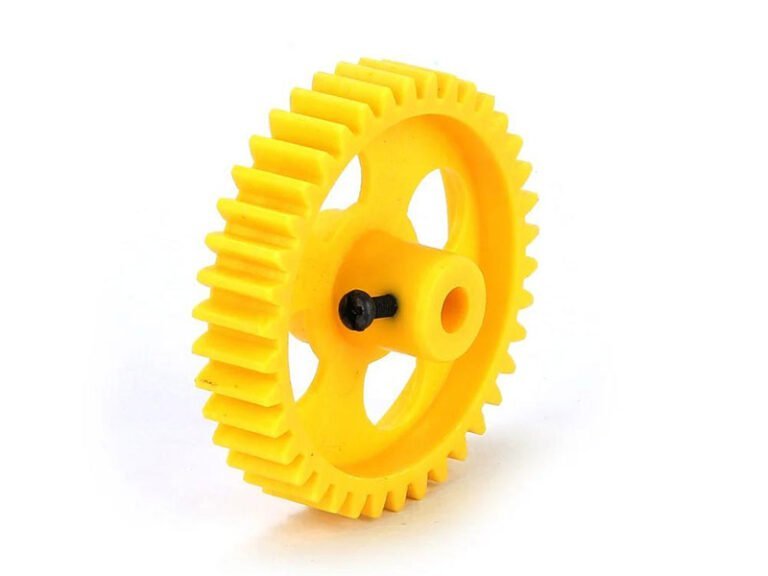In contemporary machinery, where demands for smoother operation, reduced noise, and higher load capacities dominate design priorities, helical gears are the preferred solution across diverse engineering fields. Their angled tooth profile enables gradual engagement and minimizes vibrations. In this article, we will explore helical gears in depth, such as the structure, mechanics, materials, and applications.
What is a Helical Gear?
A helical gear consists of a cylindrical form with teeth cut at an angle to the axis of rotation, typically between 8° and 45°, forming a helix pattern that facilitates progressive meshing. The basic structure includes a hub, web, and rim, with involute tooth profiles ensuring constant velocity ratios; key parameters encompass helix angle (dictating axial thrust), module, pressure angle (often 20°), and face width.
Common installation methods involve parallel shafts for standard power transmission or skewed axes in non-parallel configurations, secured via keyways, setscrews, or interference fits on shafts.

How Helical Gears Work?
Helical gears transmit power through gradual tooth contact along the helix angle. As the gear rotates, teeth engage progressively across the face width, which distributes the load over multiple teeth, typically more than in straight (spur) gears. This ensures smoother torque transfer, quieter operation, and less stress on each tooth.
However, angled teeth generate axial thrust proportional to the helix angle, requiring thrust bearings to handle these forces. In parallel shafts, the rotation direction is the same as with spur gears.
Main Types of Helical Gears
Helical gears are available in several variations to accommodate different mechanical layouts:
- Parallel-Axis Helical Gears: Designed to mesh on parallel shafts, providing smooth and efficient power transmission.
- Crossed-Axis Helical Gears: Designed for non-parallel, non-intersecting shafts, allowing power transfer at compact angles.
- Double Helical (Herringbone) Gears: Feature two opposing sets of helical teeth that cancel out axial thrust while maintaining smooth operation. Ideal for heavy-load applications without the need for additional thrust bearings.
- Comparison of Single vs. Double Helical Gears: Single helical gears are simpler but require thrust management, while double helical gears eliminate axial thrust but increase complexity and cost.
Common Materials for Helical Gears
Material selection is critical for the performance and longevity of helical gears. Common materials include:
Plastic for Helical Gears
Plastics lead in low-load, high-precision applications. Materials like nylon, acetal (POM), and polycarbonate offer self-lubrication, reducing wear and eliminating external lubricants in clean environments. They dampen vibrations effectively, achieving noise reductions up to 10 dB compared to metals, and resist corrosion in humid or chemical settings. Injection molding enables complex geometries with tight tolerances, lightweight construction, and cost savings in volume production.
Other Materials for Helical Gears
Steel alloys provide strength for demanding uses. Cast iron offers damping. Bronze ensures quiet operation in specific pairings.
Common Manufacturing Processes for Helical Gears
Injection Molding: This method is applied for plastic helical gears, allowing high-volume, low-cost production.
Milling: Milling with form cutters suits prototypes, while grinding refines surfaces post-heat treatment for minimal backlash. Skewed-axis types often employ generating methods on CNC machines.
Hobbing: Hobbing dominates helical gear production. A specialized hob cutter generates the helix via continuous indexing, achieving high precision (AGMA 10-12) in mass runs.
Powder Metallurgy: Powder metallurgy compacts and sinter for net-shape plastics or metals, minimizing waste.
Main Advantages of Helical Gears
- Smooth & Quiet Operation: The angled teeth engage gradually, resulting in quieter and smoother power transmission compared to straight-toothed gears, extending component life.
- High Load Capacity: Multiple teeth in contact simultaneously transmit greater torque with even load distribution.
- Extended Durability: Lower impact stress and better lubrication compatibility prolong service life.
- Design Versatility: Supports parallel/angled shafts, compact arrangements, and customizable ratios for flexible mechanical design.
- Reliable Performance: Predictable calculations ensure consistent torque, speed, and axial force management.
- Customizability: Gear ratios can be adjusted by changing the number of teeth, making helical gears adaptable to different speed and torque requirements.
Limitations of Helical Gears
While helical gears offer significant benefits, they also have certain limitations:
- Axial Thrust: The angled teeth generate axial force, requiring bearings to absorb additional loads.
- Manufacturing Complexity: Helical gears are more complex and costly to produce than straight-toothed gears.
- Alignment Sensitivity: Misalignment accelerates wear more than in straight-tooth designs.
- Cost Consideration: Due to the increased complexity and material requirements, helical gears are generally more expensive than spur gears.
- Heat Generation: Higher speeds amplify thermal buildup, needing cooling in enclosed systems.
Applications of Helical Gears
Helical gears excel in specific scenarios requiring precision and durability.
- Automotive Transmissions: Manage gear shifts at 3000-6000 rpm with minimal whine.
- Wind Turbine Gearboxes: Double helical types handle variable loads up to 5 MW without thrust issues.
- CNC Machine Spindles: Crossed-axis variants enable angular adjustments in tight spaces.
- Food Processing Conveyors: Plastic helicals ensure hygienic, lubricant-free operation at constant speeds.
- Chemical Plant Pump Drives: Bronze pairings resist corrosive fluids while maintaining flow rates.
Conclusion
Gears come in a variety of types of gear to meet different mechanical needs. Among them, helical gears offer smoother operation, higher load capacity, and quieter performance, while spur gears are simpler and more cost-effective for moderate-speed applications. Jiangzhi guides clients through every stage, including material selection, design guidance, and full-scale production, ensuring efficient and reliable gear solutions.



